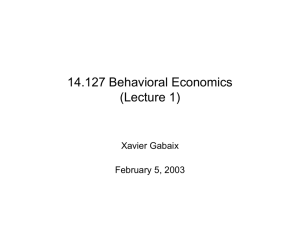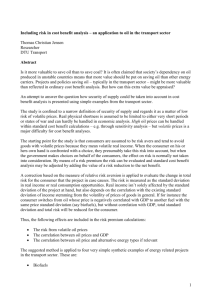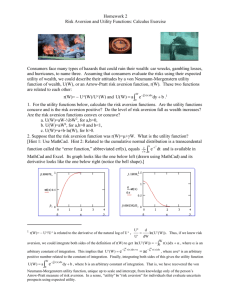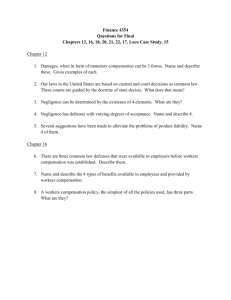Risk Aversion
advertisement
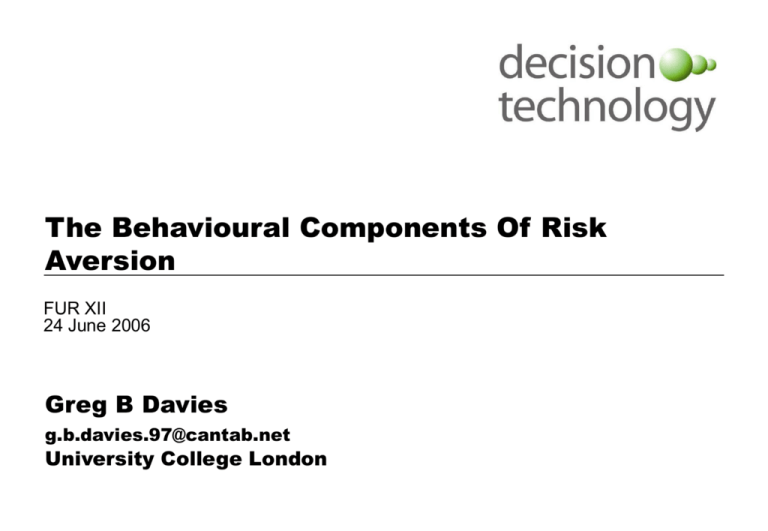
The Behavioural Components Of Risk Aversion FUR XII 24 June 2006 Greg B Davies g.b.davies.97@cantab.net University College London INTRODUCTION: THERE IS MORE TO RISK ATTITUDE THAN DIMINISHING MARGINAL UTILITY • Traditional economic theory has had a particularly simple view of risk attitude – Based on Expected Utility Theory – Identified with diminishing marginal utility for wealth • No recognition of psychology – Psychophysics of value: different curves for gains and losses – Loss aversion – Psychophysics of probability perception • We analyse the risk premium in a CPT framework and break overall risk attitude down into the underlying behavioural components FUR XII Copyright © 2006 Page 1 EXPECTED UTILITY THEORY: THE “RATIONAL” STANDARD • Individuals always choose the option with the highest expected utility: EU = E[v(x)] Value Function Utility • Assumes utility is a function of wealth – Often diminishing marginal returns (implied risk aversion) – Underlying function is stable – Options can be evaluated independently Increases in Utility get slower as wealth increases • Individuals accurately use subjective assessments of probability FUR XII Copyright © 2006 Total Wealth (£) Page 2 RISK ATTITUDE MAY BE MEASURED BY THE RISK PREMIUM • Risk premium: difference in utility between holding the gamble, and holding the EV of the gamble for sure: v(E[x] - rp) = E[v(x)] Value Function Utility Utility of EV • Risk premium always positive for a concave value function • Positive risk premium indicates Risk Aversion Risk Premium Utility of Gamble • Requires gamble outcomes to be defined on single numerical scale EV of Gamble FUR XII Copyright © 2006 Total Wealth (£) Page 3 RESULTS FROM EXPERIMENTAL PSYCHOLOGY SUGGEST A VERY DIFFERENT VALUE FUNCTION Cumulative Prospect Theory Value Function Reference Points • People evaluate utility as gains or losses from a reference point not relative to total wealth Utility Loss Aversion • People are far more sensitive to losses than to gains Reference Point Gains (£) Losses (£) Diminishing Sensitivity • Weber/Fechner law away from reference point • Risk seeking behaviour for losses Status Quo Bias/Endowment Effect • People demand more to give up an object than they are willing to pay FUR XII Copyright © 2006 Loss aversion: steeper for losses V[f] = EB[v(x)] Page 4 IN RANK DEPENDENT UTILITY THEORIES DECISION WEIGHTS ADD A FURTHER SOURCE OF RISK ATTITUDE Probability Transformation Function 1 Underweighting of probability of middle outcomes of gamble Weighting • Principle of Attention – Diminishing sensitivity to probability away from extreme outcomes • Psychological interpretation – Optimism/Hope – Convex function – Pessimism/Fear – Concave Function “The attention given to an outcome depends not only on the probability of the outcomes but also on the favourability of the outcome in comparison to the other possible outcomes” - Diecidue and Wakker (2001) FUR XII Most sensitive (steepest) at extreme outcomes: probability overweighting 0 Copyright © 2006 Cumulative or Decumulative Probability 1 Page 5 THE RISK PREMIUM MAY BE ANALYSED IN THE FRAMWORK PROVIDED BY CPT… • The concept of risk premium may be applied to the CPT framework – CPT valuation of prospect f is given by V[f] – CPT value function given by v(x) • Standard CPT Risk Premium rCPT: – v(E[f] - rCPT) = V[f] – Certain amount that would make the decision maker indifferent between the prospect and the expected value minus the risk premium – Shows the degree of risk aversion individuals believe themselves to have • Behavioural Risk Premium rB: – v(EB[f] - rB) = V[f] – EB[f] is the Behavioural Expected Value that takes decision weight distortions into account – Shows the degree of risk aversion individuals will demonstrate by their behaviour FUR XII Copyright © 2006 Page 6 WE MAY APPROXIMATE THE DEGREE OF LOCAL RISK AVERSION USING PRATT’S METHODOLOGY • Pratt-Arrow risk premium – Shows how local risk attitude is affected by the curvature of the EUT value function – rp = -σ2v’’(x)/2v’(x) • We use Pratt’s methodology to get local approximations for the CPT risk premia at the reference point with no decision weights (at first) • Standard Pratt-Arrow risk premium is a special case of CPT risk premium at reference point under three conditions – Slope of value function at reference point the same for gains and losses – Curvature at reference point the same for gains and losses – Outcome distribution is symmetrical at reference point • Away from the reference point the CPT risk premium is the same as Pratt-Arrow FUR XII Copyright © 2006 Page 7 THE CPT RISK PREMIUM IS MADE UP OF TWO COMPONENTS REPRESENTING CURVATURE AND LOSS AVERSION • rCPT is made up of two terms: 1. Curvature component: analogous to Pratt-Arrow, but numerator is a weighted average of σ2v’’(x) taken above and below the reference point, where the weights are probability of a loss and of a gain 2. Loss Aversion Component: first order effect of loss aversion always increases risk aversion • Concavity of both gains and losses is not necessary to ensure risk aversion: convexity for losses is consistent with risk aversion as long as the value function for gains is sufficiently concave • Loss aversion has second order effect through affecting the slope of the loss value function – if it gets too high this can dominate and reduce risk aversion • Adding decision weights makes the two components much more complicated but does not add an additional component FUR XII Copyright © 2006 Page 8 AN EXAMPLE USING S&P 500 RETURNS ILLUSTRATES THE EFFECT OF CPT PARAMETERS ON THE RISK PREMIUM rCPT for Different Curvatures of Gain and Loss Value Functions Loss Convexity rCPT for Different Decision Weighting and Loss Aversion Gain Concavity Decision Weighting Loss Aversion 1 – no weighting <1 – Inverse-S >1 – S-Shaped FUR XII Copyright © 2006 Page 9 INDIVIDUALS MAY BELIEVE THEMSELVES TO BE RISK AVERSE BUT YET BEHAVE AS A RISK SEEKER • The difference between the CPT risk premium and the behavioural risk premium is the Attitudinal Premium (AP) AP = rCPT – rB = E[f] – EB[f] • AP shows the difference between individuals’ beliefs of their own risk aversion, and the risk aversion imputed from their behaviour CPT vs Behavioural Risk Aversion (Illustrative Example: S&P 500 Returns) CPT Risk Premium Inverse-S shaped decision weighting curve: People believe themselves to be more risk averse than they actually behave Behavioural Risk Premium People think they are risk seeking, but are actually risk averse… S shaped decision weighting curve: People believe themselves to be less risk averse than they actually behave Decision Weighting Parameter FUR XII Copyright © 2006 Page 10
